Today i will try to write about Cisco Enterprise Architectuer. And for all i have been writen about this topic (original articel) you can found at http://www.ciscopress.com/articles/article.asp?p=2202410&seqNum=5 .Thank you for visiting to my blog and happy reading.
Cisco Enterprise Architecture (1.2)
The Cisco Enterprise Architecture is a modular approach to network design. This section identifies enterprise architecture modules that are commonly found in medium-to-large organizations.
Modular Design (1.2.1.1)
While the hierarchical network design works well within the campus infrastructure, networks have expanded beyond these borders. As shown in Figure 1-9, networks have become more sophisticated and complex. The central campus site now requires connections to branch sites and support for teleworking employees working from home offices or other remote locations. Large organizations may also require dedicated connections to offsite data centers.
As the complexity of the network increased to meet these demands, it became necessary to adjust the network design to one that uses a more modular approach.
A modular network design separates the network into various functional network modules, each targeting a specific place or purpose in the network. The modules represent areas that have different physical or logical connectivity. They designate where different functions occur in the network. Using a modular approach has several benefits, including
- Failures that occur within a module can be isolated from the remainder of the network, providing for simpler problem detection and higher overall system availability.
- Network changes, upgrades, or the introduction of new services can be made in a controlled and staged fashion, allowing greater flexibility in the maintenance and operation of the campus network.
- When a specific module no longer has sufficient capacity or is missing a new function or service, it can be updated or replaced by another module that has the same structural role in the overall hierarchical design.
- Security can be implemented on a modular basis allowing for more granular security control.
The use of modules in network design enables flexibility and facilitates implementation and troubleshooting.
Modules in the Enterprise Architecture (1.2.1.2)
A modular approach to network design further divides the three-layer hierarchical design by pulling out specific blocks or modular areas. These basic modules are connected together via the core of the network.
Basic network modules include
-
Access-distribution: Also called the distribution block, this is the most familiar element and fundamental component of a campus design (see Figure 1-10).
-
Services: This is a generic block used to identify services such as centralized Lightweight Access Point Protocol (LWAPP) wireless controllers, unified communications services, policy gateways, and more (see Figure 1-11).
-
Data center: Originally called the server farm. This block is responsible for managing and maintaining many data systems that are vital to modern business operations. Employees, partners, and customers rely on data and resources in the data center to effectively create, collaborate, and interact (see Figure 1-12).
-
Enterprise edge: Consists of the Internet edge and the WAN edge. These blocks offer connectivity to voice, video, and data services outside the enterprise (seeFigure 1-13).
Access-distribution: Also called the distribution block, this is the most familiar element and fundamental component of a campus design (see Figure 1-10).
Services: This is a generic block used to identify services such as centralized Lightweight Access Point Protocol (LWAPP) wireless controllers, unified communications services, policy gateways, and more (see Figure 1-11).
Data center: Originally called the server farm. This block is responsible for managing and maintaining many data systems that are vital to modern business operations. Employees, partners, and customers rely on data and resources in the data center to effectively create, collaborate, and interact (see Figure 1-12).
Enterprise edge: Consists of the Internet edge and the WAN edge. These blocks offer connectivity to voice, video, and data services outside the enterprise (seeFigure 1-13).
Cisco Enterprise Architecture Model (1.2.2)
The Cisco Enterprise Architecture is a modular approach to network design. This topic discusses the enterprise campus module, enterprise edge module, and the service provider edge module.
Cisco Enterprise Architecture Model (1.2.2.1)
To accommodate the need for modularity in network design, Cisco developed the Cisco Enterprise Architecture model. This model provides all the benefits of the hierarchical network design on the campus infrastructure, and facilitates the design of larger, more scalable networks.
The Cisco Enterprise Architecture model separates the enterprise network into functional areas that are referred to as modules. The modularity that is built in to the architecture allows flexibility in network design and facilitates implementation and troubleshooting.
As shown in Figure 1-14, the following are the primary Cisco Enterprise Architecture modules:
- Enterprise campus
- Enterprise edge
- Service provider edge
Connected to the service provider edge are the remote modules, including
- Enterprise branch
- Enterprise teleworker
- Enterprise data center
Cisco Enterprise Campus (1.2.2.2)
A campus network is a building or group of buildings connected into one enterprise network that consists of many LANs. A campus is generally limited to a fixed geographic area, but it can span several neighboring buildings (for example, an industrial complex or business park environment). Regional offices, SOHOs, and mobile workers may need to connect to the central campus for data and information.
The enterprise campus module describes the recommended methods to create a scalable network while addressing the needs of campus-style business operations. The architecture is modular and can easily expand to include additional campus buildings or floors as the enterprise grows.
As shown in Figure 1-15, the enterprise campus module consists of the following submodules:
- Building access
- Building distribution
- Campus core
- Data center
Together these submodules
- Provide high availability through a resilient hierarchical network design
- Integrate IP communications, mobility, and advanced security
- Utilize multicast traffic and QoS to optimize network traffic
- Provide increased security and flexibility using access management, VLANs, and IPsec VPNs
The enterprise campus module architecture provides the enterprise with high availability through a resilient multilayer design, redundant hardware and software features, and automatic procedures for reconfiguring network paths when failures occur. Integrated security protects against and mitigates the impact of worms, viruses, and other attacks on the network, even at the switch port level.
A high-capacity, centralized data center module can provide internal server resources to users. The data center module typically also supports network management services for the enterprise, including monitoring, logging, troubleshooting, and other common management features from end to end. The data center submodule typically contains internal email and corporate servers that provide application, file, print, email, and Domain Name System (DNS) services to internal users.
Cisco Enterprise Edge (1.2.2.3)
The enterprise edge module provides connectivity for voice, video, and data services outside the enterprise. This module often functions as a liaison between the enterprise campus module and the other modules.
As shown in Figure 1-16, the enterprise edge module consists of submodules providing
- E-commerce services
- Internet connectivity
- Remote access and VPN access
- WAN site-to-site VPN access
Specifically, these submodules consist of:
- E-commerce networks and servers: The e-commerce submodule enables enterprises to support e-commerce applications through the Internet. It uses the high-availability designs of the data center module. Devices located in the e-commerce submodule include web, application, and database servers; firewall and firewall routers; and network intrusion prevention systems (IPS).
- Internet connectivity and demilitarized zone (DMZ): The Internet submodule of the enterprise edge provides internal users with secure connectivity to Internet services such as public servers, email, and DNS. Connectivity to one or several Internet service providers (ISPs) is also provided. Components of this submodule include firewall and firewall routers, Internet edge routers, FTP and HTTP servers, SMTP relay servers, and DNS servers.
- Remote access and VPN: The VPN/remote access submodule of the enterprise edge provides remote-access termination services, including authentication for remote users and sites. Components of this submodule include firewalls, dial-in access concentrators, Cisco Adaptive Security Appliances (ASA), and network intrusion prevention system (IPS) appliances.
- WAN: The WAN submodule uses various WAN technologies for routing traffic between remote sites and the central site. Enterprise WAN links include technologies such as Multiprotocol Label Switching (MPLS), Metro Ethernet, leased lines, Synchronous Optical Network (SONET) and Synchronous Digital Hierarchy (SDH), PPP, Frame Relay, ATM, cable, digital subscriber line (DSL), and wireless.
Service Provider Edge (1.2.2.4)
Enterprises use service providers (SPs) to link to other sites. As shown in Figure 1-17, theSP edge module can include
- Internet service providers (ISPs)
- WAN services such as Frame Relay, ATM, and MAN
- Public switched telephone network (PSTN) services
The SP edge provides connectivity between the enterprise campus module to the remote enterprise data center, enterprise branch, and enterprise teleworker modules.
The SP edge module
- Spans across large geographic areas in a cost effective manner
- Converges voice, video, and data services over a single IP communications network
- Supports QoS and service level agreements
- Supports security using VPNs (IPsec / MPLS) over Layer 2 and Layer 3 WANs
When acquiring Internet services from an ISP, redundancy or failover should be considered. Redundant Internet connections vary depending if the enterprise is connecting to a single ISP or multiple ISPs.
As shown in Figure 1-18, redundant connections to a single ISP can include
- Single-homed: A single connection to an ISP
- Dual-homed: Two or more connections to a single ISP
Alternatively, it is possible to set up redundancy using multiple ISPs, as shown in
Figure 1-19. Options for connecting to multiple ISPs include
- Multihomed: Connections to two or more ISPs
- Dual-multihomed: Multiple connections to two or more ISPs
Remote Functional Area (1.2.2.5)
The remote functional area is responsible for remote connectivity options and includes the following modules, as shown in Figure 1-20.
Enterprise Branch
The enterprise branch module includes remote branches that allow employees to work at noncampus locations. These locations are typically responsible for providing security, telephony, and mobility options to employees, as well as general connectivity into the campus network and the different components located inside the enterprise campus. The enterprise branch module allows enterprises to extend head-office applications and services, such as security, Cisco Unified Communications, and advanced application performance, to the remote branches. The edge device connecting the remote site to the central site varies depending on the needs and size of the site. Large remote sites may use high-end Cisco Catalyst switches, while smaller sites may use an ISR G2 router. These remote sites rely on the SP edge to provide services and applications from the main site. In Figure 1-20, the enterprise branch module connects to the enterprise campus site primarily using a WAN link. However, it also has an Internet link as a backup. The Internet link uses site-to-site IPsec VPN technology to encrypt corporate data.
Enterprise Teleworker
The enterprise teleworker module is responsible for providing connectivity for workers who operate out of different geographically dispersed locations, including home offices, hotels, or customer/client sites. The teleworker module recommends that mobile users connect to the Internet using the services of a local ISP, such as cable modem or DSL. VPN services can then be used to secure communications between the mobile worker and central campus. Integrated security- and identity-based networking services enable the enterprise to extend campus security policies to the teleworker. Staff can securely log in to the network over the VPN and gain access to authorized applications and services from a single cost-effective platform.
Enterprise Data Center
The enterprise data center module is a data center with all of the same functional options as a campus data center, but exists at a remote location. This provides an added layer of security as the offsite data center can provide disaster recovery and business continuance services for the enterprise. High-end switches such as the Cisco Nexus series switch use fast WAN services such as Metro Ethernet (MetroE) to connect the enterprise campus to the remote enterprise data center. Redundant data centers provide backup using synchronous and asynchronous data and application replication. Additionally, the network and devices offer server and application load balancing to maximize performance. This solution allows the enterprise to scale without major changes to the infrastructure.







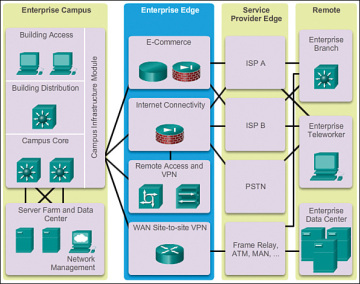
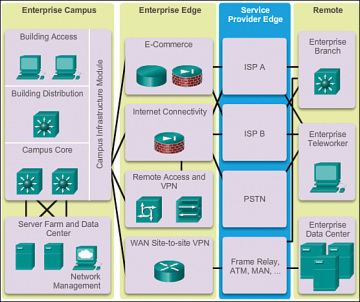
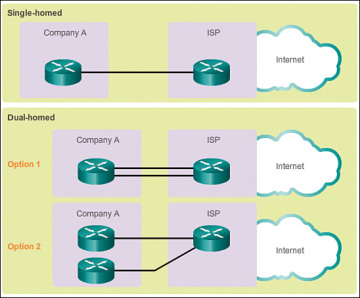
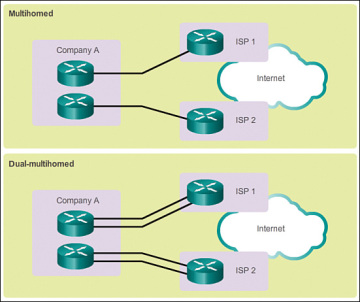
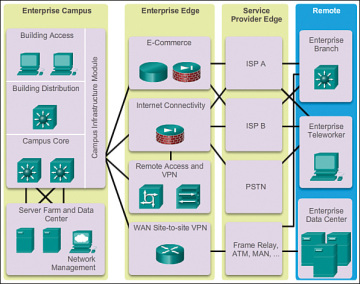
this is an amazing architecture, and well explained. thank you.
BalasHapus